Advertisements
Advertisements
प्रश्न
You are given four sources of light each one providing a light of a single colour – red, blue, green and yellow. Suppose the angle of refraction for a beam of yellow light corresponding to a particular angle of incidence at the interface of two media is 90°. Which of the following statements is correct if the source of yellow light is replaced with that of other lights without changing the angle of incidence?
पर्याय
The beam of red light would undergo total internal reflection.
The beam of red light would bend towards normal while it gets refracted through the second medium.
The beam of blue light would undergo total internal reflection.
The beam of green light would bend away from the normal as it gets refracted through the second medium.
उत्तर
The beam of blue light would undergo total internal reflection.
Explanation:
According to the Cauchy relationship, `lambda oo 1/mu`
Smaller the wavelength higher the refractive index and consequently smaller the critical angle.
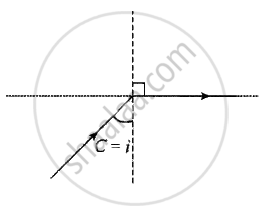
We know `v = flambda`, the frequency of wave remains unchanged with medium hence `v oo lambda`.
The critical angle, sin C = `1/mu`
Also, velocity of light, `v oo 1/mu`
According to VIBGYOR, among all given sources of light, the blue light have smallest wavelength, As `lambda_("blu") < lambda_("yellow")` hence `v_("blue") < v_("yellow")`, it means `mu_("blue") > mu_("yellow")`
It means critical angle for blue is less than yellow colour, the critical angle is least which facilitates total internal reflection for the beam of blue light.
APPEARS IN
संबंधित प्रश्न
A double convex lens is made of a glass of refractive index 1.55, with both faces of the same radius of curvature. Find the radius of curvature required, if the focal length is 20 cm.
Following figure shows three transparent media of refractive indices \[\mu_1 , \mu_2 \text{ and } \mu_3\]. A point object O is placed in the medium \[\mu_2\]. If the entire medium on the right of the spherical surface has refractive index \[\mu_3\], the image forms at O". In the situation shown,
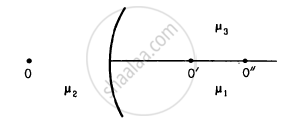
A U-shaped wire is placed before a concave mirror having radius of curvature 20 cm as shown in figure. Find the total length of the image.
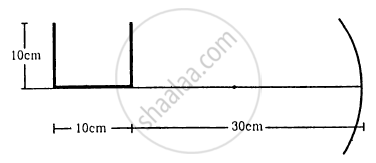
State how the focal length of a glass lens (Refractive Index 1.5) changes when it is completely immersed in:
(i) Water (Refractive Index 1.33)
(ii) A liquid (Refractive Index 1.65)
Answer the following question.
With the help of a ray diagram, obtain the relation between its focal length and radius of curvature.
According to the mirror equation, ______.
The intensity of a point source of light, S, placed at a distance d in front of a screen A, is I0 at the center of the screen. Find the light intensity at the center of the screen if a completely reflecting plane mirror M is placed at a distance d behind the source, as shown in the figure.
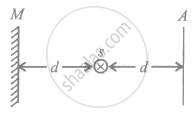
A spherical mirror is obtained as shown in the figure from a hollow glass sphere. if an object is positioned in front of the mirror, what will be the nature and magnification of the image of the object? (Figure drawn as schematic and not to scale)
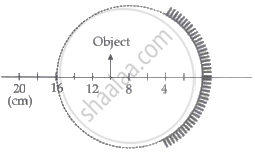
A concave mirror of focal length 12 cm forms three times the magnified virtual image of an object. Find the distance of the object from the mirror.
Why does a car driver use a convex mirror as a rear-view mirror?
